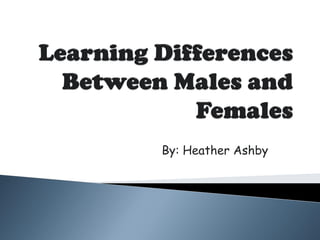
Learning Differences
- 2. • Gray matter • White MAtter • Cerebral Cortex • Cerebrum • Frontal lobes, parietal lobes, occipital lobes, temporal lobes • Cerebellum • Thalamus- Hypothalamus • Brain Stem (“Brain”)
- 3. • More gray matter- activity stays in one area • “A boy's brain "shuts off" (enters a rest state) more times per day than a girl's brain tends to do” (Gurian) • More neural centers- better focus • Less active Hippocampus- worse memory • “Systemizing tendencies- the drive to analyze, explore, and construct a system” (Kanazawa)
- 4. • Different sized parts of the brain • More white matter (Edmunds) • Activity in more than one area • “Empathizing Tendencies- drive to identify another person’s emotions and thoughts, and to respond to them with an appropriate emotion” (Kanazawa)
- 6. • prefer to work alone • often disrupt class when they become bored and act out instead of working • sometimes lose focus when they become upset • tend to have messy handwriting and disorganized work • need space to move around in and to work (“Boys”)
- 7. • perform well in groups • find things to work on between assignments • good at listening • focus on more than one thing at a time • tend to have neater handwriting (“Boys”)
- 8. • Pros- • able to pursue interests without peer pressure • “more diverse role models of their own gender” (“Advantages”) • Cons- • not enough time with the opposite gender • real life is co-ed (Danish)
- 9. • “Title IX of the Education Amendments of 1972 reads in part, "No person in the United States shall, on the basis of sex, be excluded from participation in, be denied the benefits of, or be subjected to discrimination under any education program or activity receiving Federal assistance.” (“Legal”)
- 10. No Child Left Behind Act- passed in January 2002 Regulations made in October 2005- state schools have to give a valid reason for wanting single-sex classrooms, they must have a co-ed class of the same subject, and they have a review every two years to see if the single-sex classroom is still necessary for the school.
- 11. • study done at Stetson University in Deland, Florida at Woodward Avenue Elementary School (“Single-Sex”) • assigned the students of the fourth grade class to either a same gender or a co-ed class, with each class having the same number of students- everything else was the same • results of the FCAT: • Co-ed: Boys- 37% Girls- 59% • Same gender: Boys- 86% Girls- 75%
- 12. • study done at Thurgood Marshall Elementary School in Seattle, Washington in 2000 (“Single- Sex”) • principal changed school from co-ed classrooms to same gender classrooms to help discipline problems • decreased discipline after change • increase in test scores
- 13. • http://mttellek.files.wordpress.com/2011/06/brain-lobes.gif • http://www.macalester.edu/psychology/whathap/ubnrp/intelligence05/ img/nate2.jpeg • http://www.google.com/imgres?hl=en&safe=active&biw=1920&bih=1106 &gbv=2&tbm=isch&tbnid=broy2Q1tXzwPMM:&imgrefurl=http://www.te xasprojectfirst.org/NCLB.html&docid=XJne6hW0GpaMUM&imgurl=htt p://www.texasprojectfirst.org/nclblogo.jpg&w=330&h=328&ei=2mGyT_ _vGMmGgwfZ062gCQ&zoom=1 • http://news.medill.northwestern.edu/chicago/news.aspx?id=73245 • http://www.nytimes.com/2009/03/11/education/11gender.html
- 14. • “Advantages for Girls.” National Association for Single-Sex Public Education. Web. 1 May 2012. • “Boys and Girls Have Different Learning Styles.” EduGuide. Web. 30 April 2012. • “Brain.” National Geographic. Web. 24 April 2012. • Danish, Elizabeth. “Pros and Cons of Single Sex Schools.” HealthGuidance. Web. 1 May 2012. • Edmunds, Molly. “Do men and women have different brains?” Discovery Fit and Health. Web. 29 April 2012. • Gurian, Michael. “Brain Differences Between Boys And Girls.” Education.com. Web. 24 April 2012. • Kanazawa, Satoshi. “Male brain vs. female brain I: Why do men try to figure out their relationships? Why do women talk to their cars?” The Scientific Fundamentalist. Psychology Today. 16 March 2008. Web. 29 April 2012. • “Legal Status of Single-Sex Education.” National Association for Single-Sex Public Education. Web. 9 May 2012. • “Single-Sex vs. Coed: The Evidence.” National Association for Single-Sex Public Education. Web. 1 May 2012.